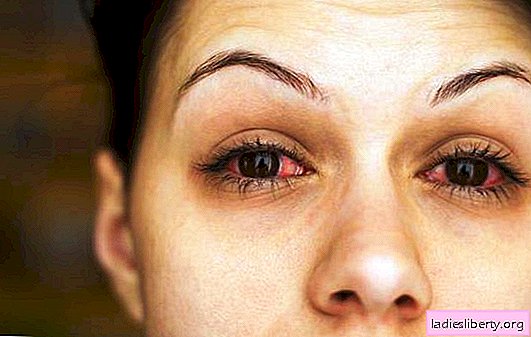
Eyelid inflammation or blepharitis is a pathological inflammatory process that can affect one or two eyes at once.
Consider in more detail the symptoms of inflammation of the eyelids and the best methods to eliminate this ailment.
Eyelid inflammation: causes
The causes of inflammation of the eyelids can be a variety of factors. Most often it provokes:
1. A bite of micro-mites that can dwell in the hair and skin of people. This happens with a sharp decrease in human immunity. Immunity itself may decrease due to stress, overwork, the presence of chronic diseases or a recent viral illness.
2. Individual sensitivity of a person to various external stimuli. For example, they can be pollen, animal hair, makeup, or ordinary household dust. In such cases, the patient will have an allergic form of blepharitis.
3. Hyperopia in humans, in which he does not wear glasses. In this state, the muscles of his eyes will be over-stressed all the time. Due to the friction of tired eyes with hands, a person can easily bring an infection there, which will cause an acute form of blepharitis.
4. Diseases of the digestive system, which provoke metabolic disorders in the body. Thus, blepharitis is often diagnosed with diabetes mellitus, colitis, gastritis, or cholecystitis. Moreover, due to malfunctions in the body's work, the functioning of the sebaceous glands between the eyelashes is severely impaired, which increases the risk of inflammation of the eyelids.
5. General violation in the lacrimal layer of the cornea of the eye.
6. The presence of chronic viral infectious diseases.
7. Damage to staphylococcus or streptococcus of the ocular membrane.
8. The presence of a progressive infection in the blood or teeth, which can penetrate the eyes and cause inflammation of the eyelids.
9. Chemical burn of the eye.
10. Eye injury.
11. An acute shortage of beneficial trace elements in the body.
12. The presence of an inflammatory process in the nasopharynx or sinuses, which began to spread to the eyes.
13. Excessive eye strain due to prolonged use of the computer or reading while lying down.
Eyelid inflammation: symptoms and signs
The general course of blepharitis largely depends on its type. Thus, each form of the disease is characterized by its symptoms:
1. Seborrheic blepharitis is accompanied by such manifestations:
• redness of the eyelids;
• burning and severe itching in the eyes;
• gluing eyelashes;
• fear of bright light;
• headaches;
• the appearance of excessive eye sensitivity;
• the formation between the eyelashes of dry scales that are tightly glued together (during treatment, such scales will begin to fall off, without damaging the skin);
• swelling of the eyelids;
• lacrimation;
• eyelash loss;
• eversion of the eyelid is observed in advanced cases.
2. Ulcerative blepharitis is accompanied by such manifestations:
• the formation of purulent ulcers in the growth zone of the eyelashes, which will bleed and become covered with a yellow coating (after healing of the ulcers, visible scars remain in their place);
• the patient has severe weakness and fear of bright light;
• plentiful loss of eyelashes;
• pain during blinking;
• temperature rise.
3. Demodectic form of blepharitis is observed with eye damage by ticks.
She has the following symptoms:
• the appearance of a very pronounced itching in the eyes;
• sleep disturbance;
• the appearance of sticky fluid from the eyelids;
• visible redness of the eyelids;
• gluing eyelashes.
In addition, when examined under a microscope in the eyelash growth zone, mites can be clearly seen.
4. Allergic blepharitis in most cases occurs in conjunction with conjunctivitis.
It is accompanied by such symptoms:
• constant tearing;
• violation of clarity of vision;
• headaches;
• sore throat;
• itchy eyes;
• the appearance of cutting pain in the eyes;
• swelling of the eyelids;
• damage to both eyes at once;
• rapid eye fatigue;
• strong eye sensitivity to cold, wind and light;
• the formation of a thin film in the eyes;
• burning in the eyes;
• change the direction of eyelash growth;
• a feeling of heaviness of the eyelids.
Eyelid inflammation: diagnosis and treatment
To detect blepharitis, a patient should be examined by a doctor and biomicroscopy should be done. This procedure will make it possible to understand the degree of eye damage and the source of inflammation.
Treatment of inflammation of the eyelids of the eye is aimed at eliminating the cause of the disease and the symptoms of the patient. Traditional therapy has such features:
1. With an allergic form of blepharitis, the allergen must first be eliminated. To do this, you may have to change cosmetics or contact lenses. Also, the patient is prescribed antiallergic eye drops and corticosteroid ointments for local use. Apply this ointment regularly several times a day.
2. With scaly form of blepharitis, it is recommended to use moisturizing drops for the eyes.
3. Ulcerative blepharitis usually develops due to the ingestion of pathogenic bacteria, so it requires the use of ointments and drops that contain antibiotics.
4. With tick-borne eye damage, the patient is prescribed antiparasitic drugs that will eliminate ticks. In this case, the course of such treatment will be long (at least two months).
5. For a general increase in immunity, it is important for a person to enrich his diet with vitamins and additionally take beneficial substances.
In addition to the main focus for the treatment of blepharitis, the patient must carefully observe eye hygiene and daily remove collecting crusts on the eyelids.
It is also advisable to adhere to the following tips in the treatment of inflammation of the eyelids:
1. Every day you need to apply warm compresses from steep tea leaves to the sore eye. This is especially useful for purulent eye damage. Infusion will clear them of purulent secretion and reduce pain.
2. No matter how much your eyes are scratched, you can’t rub them with your hands, since in this way you can spread the infection even more. Instead, when itching, you need to rinse your eyes and lubricate them with ointments.
3. For the treatment period, it is important to completely abandon the application of decorative cosmetics not only to the eyes, but also to the entire face.
4. For the treatment period, it is recommended to minimize eye strain. This means that it is better to refrain from working at the computer and reading. If the load on the eyes is mandatory (associated with professional activity), then you need to at least take breaks every half an hour and just give your eyes a rest.
5. Usually, blepharitis treatment is carried out at home, but still the patient must always visit a doctor to monitor his condition.
6. Very useful are lotions for the eyes, which are made from decoctions of chamomile, cornflower or calendula. They have a pronounced antibacterial and anti-inflammatory effect, so they will help even with an advanced form of blepharitis. It is recommended to apply such lotions to the eyes twice a day for several minutes.
7. A decoction of wheat or caraway seeds is considered equally effective. This tool is also useful to rinse the eyes.
Eyelid inflammation: treatment and prevention
To prevent the development of blepharitis, it is recommended to follow these tips:
1. Improve your immunity, especially after a recent illness. To do this, you need to have a healthy sleep, eat well, play sports and be tempered. Also, you must take vitamin complexes.
2. Lead a healthy lifestyle and give up bad habits.
3. Do not stress yourself, as it lowers immunity.
4. Be sure to wear glasses for eye problems.
5. Do not use other people's hygiene products and towels.
6. It is necessary to carefully observe eye hygiene.
7. Do not use low-quality cosmetics with eye sensitivity.
8. Never rub your eyes with dirty hands, even if they are very itchy. In extreme cases, you can wipe your eyes with a clean bactericidal napkin.
9. If at home one of the family members is ill with blepharitis, it is necessary to ensure that healthy people do not lie on the patient’s pillow, since this disease can also be infected.
10. When the first signs of the disease appear, you should immediately contact an ophthalmologist.
11. In time to treat those diseases that can cause inflammation of the eyelids.











